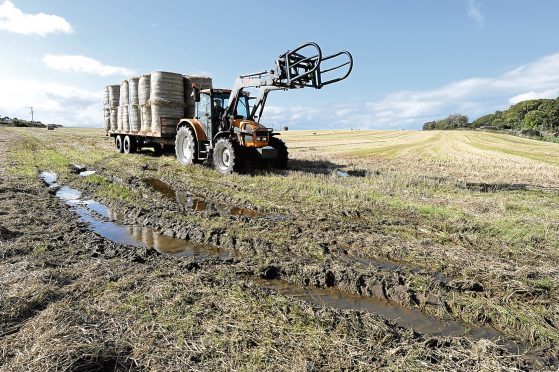Harvest 2017 has been branded “difficult and costly for most” despite figures suggesting 4% more cereals were grown this year.
The Scottish Government’s chief statistician has released the latest estimates for the 2017 Scottish cereal and oilseed rape harvest.
The figures were downgraded on initial estimates, which suggested a bumper crop of 3.1million tonnes, to 2.9million tonnes produced in the year. This is up 4% on the 2016 harvest and includes 1.8million tonnes of barley and 900,000 tonnes of wheat.
Government said the increase in production was due to an 11% increase in barley, which offset a 4% fall in wheat.
The overall area of land sown increased by 1% to 1.069million acres, and overall yields averaged 2.67 tonnes per acre, ranging from 2.3 tonnes per acre for oats to 3.27 tonnes per acre for wheat.
Spring barley harvest increased by 140,000 tonnes to 1.43million tonnes, and winter barley increased by 23,000 tonnes to 352,000 tonnes. Wheat harvest decreased by 37,000 tonnes to 889,000 tonnes, and the oats harvest decreased by 8% to 185,000 tonnes.
Oilseed rape yields performed above the long-term trend, averaging 1.7 tonnes per acre with a total production of 144,000 tonnes.
The government statistical notice said: “Those farms that harvested early were able to benefit from the higher yields resulting from the wet summer. This was particularly true for barley.
“Those harvesting later found it increasingly difficult to find a window of a few good days to dry out the crop and get the combine into the fields. This meant that often substantial amounts of crop were lost.”
Rural Economy Secretary Fergus Ewing said the results showed the impact of weather on this year’s harvest. He said: “This year’s harvest has been a mixed bag evidenced by the drop in production across the south-west, compared to increases in the rest of Scotland.
“This appears to have largely been as a result of the unusually wet weather we have had this year, which is why I announced the establishment of a weather advisory panel, that met for the first time last week, to advise on building longer-term resilience within our sector.”
He hailed a 7% increase in yields against the 10-year average and said it was down to improved efficiency on Scottish farms.
NFU Scotland’s combinable crops committee chairman Ian Sands, said: “The reality of the 2017 harvest is that, as a result of wet weather, quite a few farmers did not finish harvest and crops have been left wasting in fields.
“The poor weather also hit quality, leading to reduced prices. For those who were looking to grow malting spring barley but failed to hit spec, the price penalty was almost £40 per tonne.
“And to compound matters, the wet weather led to increased drying costs and hundreds of fields of straw have gone unbaled. All in all, it has been a difficult and costly harvest for most.”










